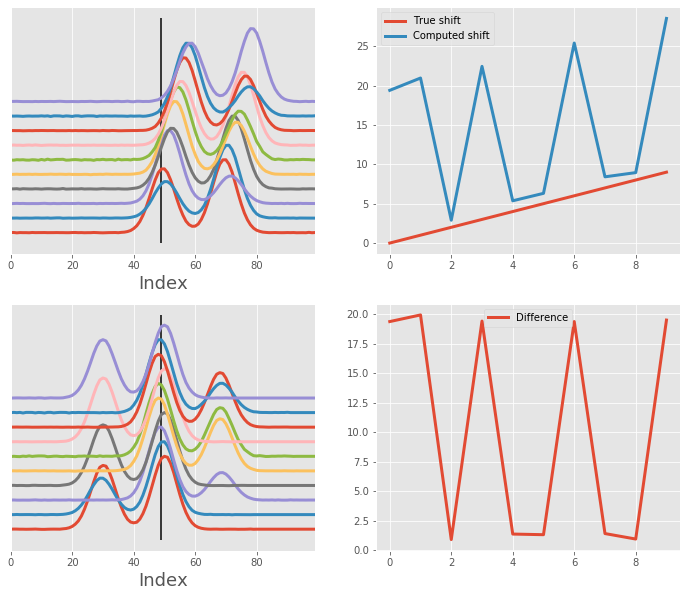Two Gaussian curve alignment¶
This notebook showcases how msalign performs when dealing with multiple curves in the signal.
The algorithm performs pretty well when aliging clean and noisy data, especially when the
ratio of the two curves is the same (or very similar)
The algoritm is a little less capable when dealing with two curves and the alignment is performed towards the smaller curve.
import numpy as np
from scipy import signal
from scipy.ndimage import shift
import matplotlib.pyplot as plt
from msalign import Aligner
plt.style.use('ggplot')
Utility functions¶
First, let's make a couple of functions that will generate data for us, as well as, show the results
def simple_two_gaussian_data(shifts, n_signals=5, n_points=100, noise=0):
"""Generate two-Gaussian signal that was shifted along the horizontal axis.
The proportion of the two conformations remains constant where the first conformation is
twice as large as the second
"""
# generate x-axis
x = np.arange(n_points)
# generate Gaussian signal
gaussian_one = signal.gaussian(n_points, std=4)
gaussian_two = shift(signal.gaussian(n_points, std=4) * 0.5, n_points * 0.2)
gaussian = gaussian_one + gaussian_two
peak = [gaussian_one.argmax(), gaussian_two.argmax()]
# pre-allocate array
array = np.zeros((n_signals, n_points))
for i in range(n_signals):
array[i] = shift(gaussian, shifts[i]) + np.random.normal(0, noise, n_points)
return x, array, shifts, peak
def variable_two_gaussian_data(shifts, n_signals=5, n_points=100, noise=0):
"""Generate two-Gaussian signal that was shifted along the horizontal axis.
The proportion of the two conformations remains constant where the first conformation is
twice as large as the second
"""
# generate x-axis
x = np.arange(n_points)
gaussian_one_intensity = np.random.randint(1, 10, n_signals) / 10
gaussian_two_intensity = np.random.randint(1, 10, n_signals) / 10
# generate Gaussian signal
gaussian_one = signal.gaussian(n_points, std=4)
gaussian_two = shift(signal.gaussian(n_points, std=4), n_points * 0.2)
peak = [gaussian_one.argmax(), gaussian_two.argmax()]
# pre-allocate array
array = np.zeros((n_signals, n_points))
for i in range(n_signals):
_gaussian = (gaussian_one * gaussian_one_intensity[i]) + (gaussian_two * gaussian_two_intensity[i])
array[i] = shift(_gaussian, shifts[i]) + np.random.normal(0, noise, n_points)
return x, array, shifts, peak
def overlay_plot(ax, x, array, peak):
"""Generate overlay plot, showing each signal and the alignment peak(s)"""
for i, y in enumerate(array):
y = (y / y.max()) + (i * 0.2)
ax.plot(x, y, lw=3)
ax.axes.get_yaxis().set_visible(False)
ax.set_xlabel("Index", fontsize=18)
ax.set_xlim((x[0], x[-1]))
ax.vlines(peak, *ax.get_ylim())
def shift_plot(ax, shift_in, shift_out):
"""Generate plot displaying the original shifts (before alignment) and corrected shifts (after alignment)"""
ax.plot(shift_in, label="True shift", lw=3)
ax.plot(shift_out, label="Computed shift", lw=3)
ax.legend()
def difference_plot(ax, shift_in, shift_out):
"""Generate plot displaying the misalignment for each signal"""
ax.plot(shift_out.flatten() - shift_in.flatten(), label="Difference", lw=3)
ax.legend()
def align_and_plot(x, array, shifts_in, peak, **kwargs):
"""Align signals and plot the results"""
# instantiate aligner object
aligner = Aligner(
x,
array,
peak,
return_shifts=True,
align_by_index=True,
only_shift=True,
method="pchip",
**kwargs
)
# align and collect data
aligner.run()
aligned_array, shifts_out = aligner.apply()
# display before and after shifting
fig, ax = plt.subplots(2, 2, figsize=(12, 10))
overlay_plot(ax[0, 0], x, array, peak)
overlay_plot(ax[1, 0], x, aligned_array, peak)
shift_plot(ax[0, 1], shifts_in, shifts_out)
difference_plot(ax[1, 1], shifts_in, shifts_out)
Alignment of array with two clean Gaussians¶
Let's realign an array of two Gaussian signals back to the original position. Here, we have 10 signals, each was shifted by one bin to the right. We will be aligning along the horizontal dimension using two peaks (the apex of each Gaussian curve of the first curve).
After the alignment, we can also plot the shift correction determined by the msalign algorithm.
# generate data
x, array, shifts_in, peak = simple_two_gaussian_data(np.arange(10), n_signals=10, n_points=100, noise=1e-3)
# align and plot
align_and_plot(x, array, shifts_in, peak)
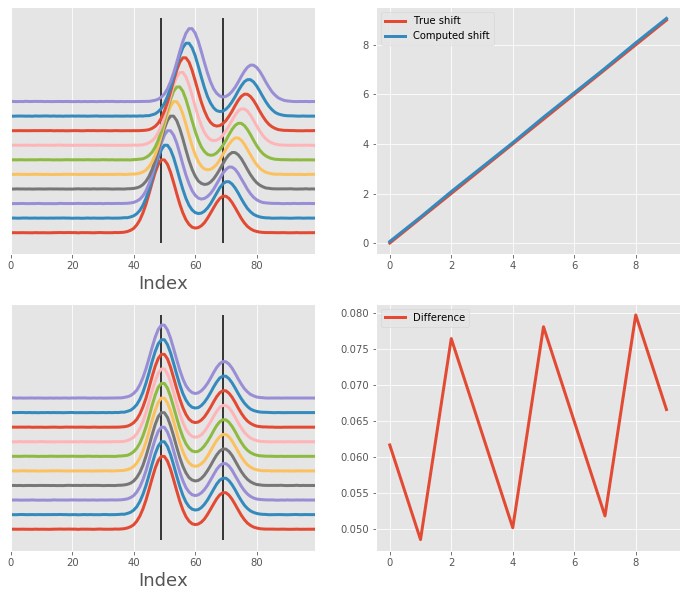
Same array as before, but aligning using one peak (from the first Gaussian)¶
This does not pose much of a problem, since the intensity of the first curve is a lot higher than the second ones.
# align and plot
align_and_plot(x, array, shifts_in, [peak[0]])
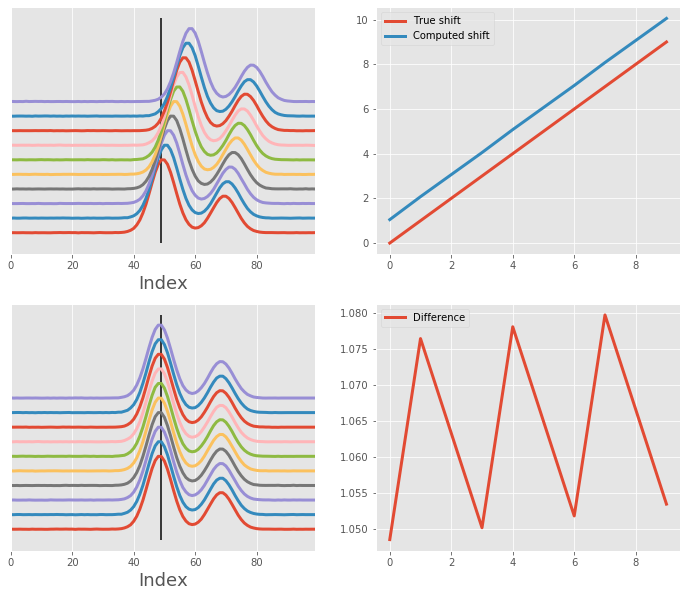
Same array as before, but aligning using one peak (from the second Gaussian)¶
This is a bit more problematic, because the algorithm will look at the maximum intensity of each curve and align against it. Rather than aligning to the second curve, which is closer to the selected peak, it will shift the entire array too far to the right.
# align and plot
align_and_plot(x, array, shifts_in, [peak[1]])
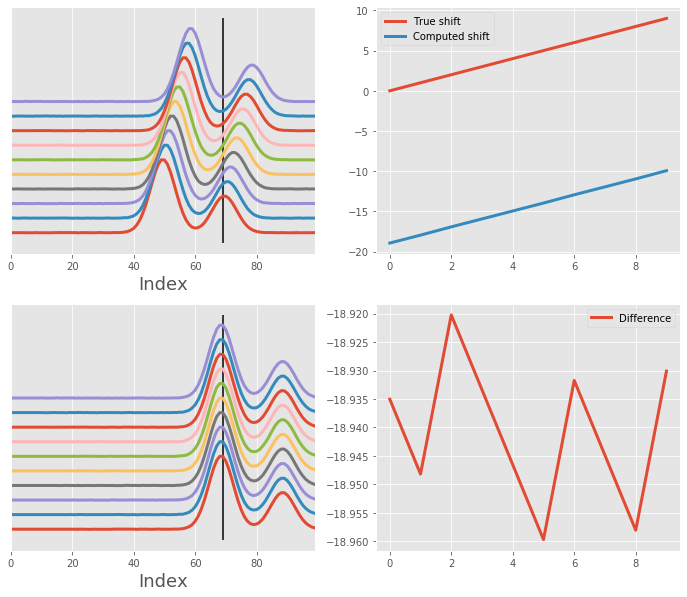
Alignment of array with two very noisy Gaussians¶
We use the same array but with quite a lot of noise. The algorithm deals with this quite well.
# generate data
x, array, shifts_in, peak = simple_two_gaussian_data(np.arange(10), n_signals=10, n_points=100, noise=1e-1)
# align and plot
align_and_plot(x, array, shifts_in, peak)
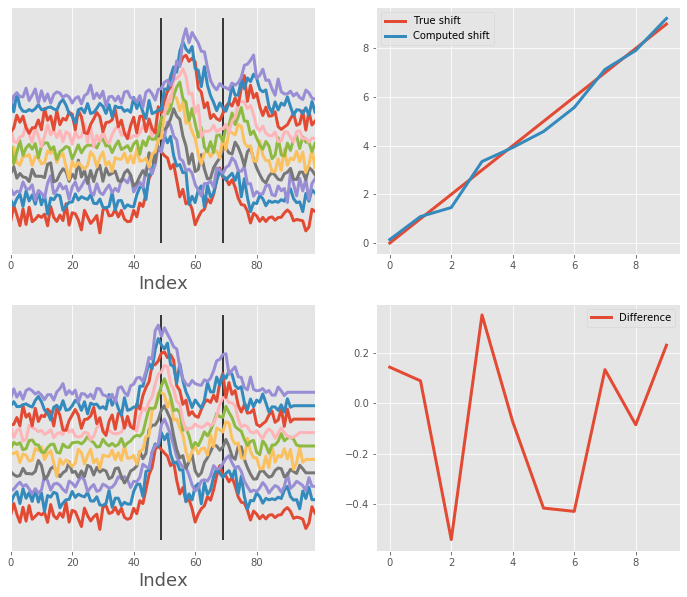
Same as abovem but aligning against the first peak only¶
# align and plot
align_and_plot(x, array, shifts_in, [peak[0]])
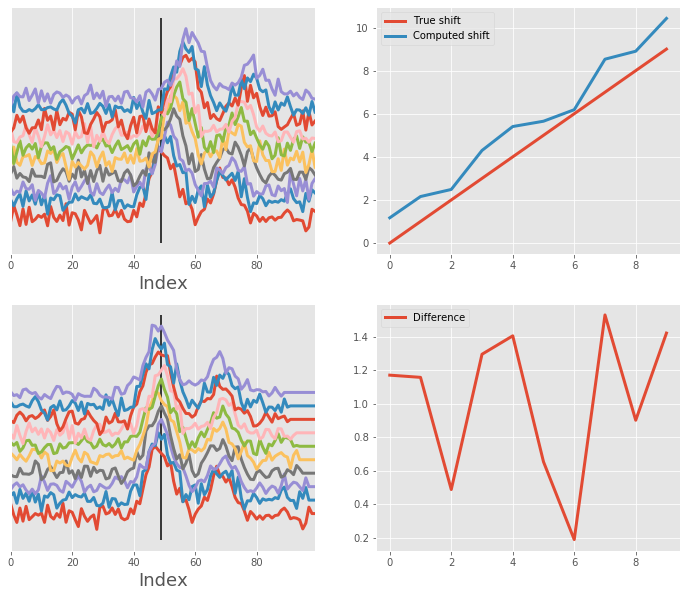
Alignment with two clean Gaussians - random shift¶
Here, we have two clean Gaussians that have been shifted left and right by some random number. We are aligning against peaks so the algorithm can do quite well.
# generate artificial shift (simple offset of by for each signal)
np.random.seed(15) # make sure we get reproducible results
shifts_in = np.random.randint(-25, 40, 10)
# generate data
x, array, shifts_in, peak = simple_two_gaussian_data(shifts_in, n_signals=10, n_points=100, noise=1e-3)
# align and plot
align_and_plot(x, array, shifts_in, peak)
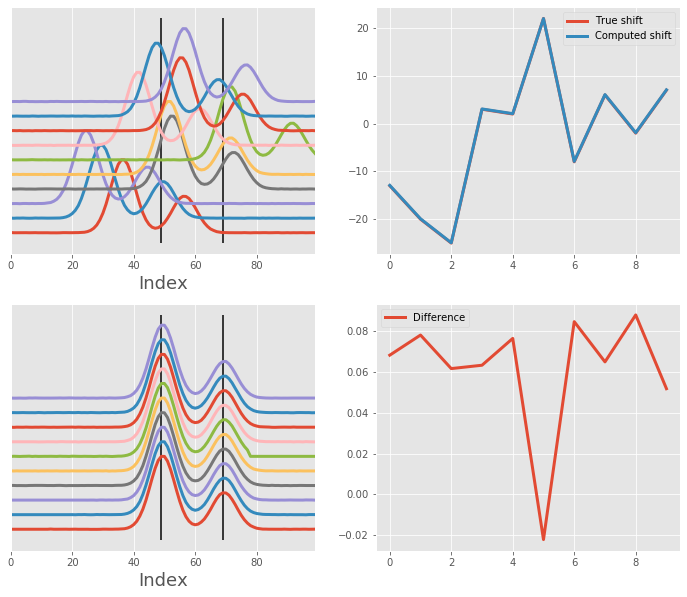
Alignment of two random Gaussians¶
Here, we are aligning two Gaussians, however, the intensity of each Gaussian is not constant. The algorithm performs reasonably well when aligning using two peaks.
# generate artificial shift (simple offset of by for each signal)
np.random.seed(42)
shifts_in = np.arange(10)
# generate data
x, array, shifts_in, peak = variable_two_gaussian_data(shifts_in, n_signals=10, n_points=100, noise=1e-3)
# align and plot
align_and_plot(x, array, shifts_in, peak)

Same as above, but using single peak¶
In cases like this, alignment using single peak will not work particularly well since the algorithm will try to align against the most dominant peak (rather than the closest peak). If possible, provide as many anchor points as you can.
# align and plot
align_and_plot(x, array, shifts_in, [peak[0]])
